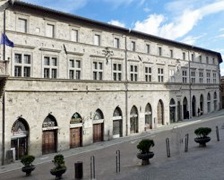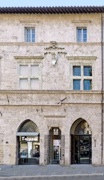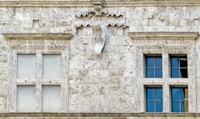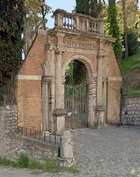



Ancient Studium
The statutes of 1285 required the Commune to establish a “Studium” in Perugia, “so that the city might shine with wisdom”. The charter for a Studium Generale was drawn up in 1306 and approved by Pope Clement V in 1308. In 1318-21, Pope John XXII granted it the privilege of conferring degrees in civil and canon law, medicine and arts. Formal imperial recognition of the University was granted in 1355, when the Emperor Charles IV, who was in Rome for his coronation, confirmed the right of Perugia to have a university.
The Studium rose to prominence in the 14th century, numbering among its academics:
-
✴the jurists Baldo of Sassoferrato (died ca. 1357) and Baldo degli Ubaldi (died 1400); and
-
✴Gentile da Foligno, the medical researcher who died in the plague of 1348.
Two residential colleges opened in the 14th and early 15th centuries for students of the Studium:
-
✴Cardinal Nicolò Capocci, who had studied law at the Studium, founded the Collegio di San Gregorio in 1362 for the maintenance of 40 poor theology students. Pope Gregory XI granted it recognition in 1371, and it became, in effect, the theological faculty of the Studium.
-
✴Bishop Benedetto Guidalotti of Recanati bought the Albergo del Leone in 1427 to provide premises for a new college, the Collegio di S. Girolamo for impecunious foreigners who wished to study law and medicine at the Studium. He died in 1429, and Pope Martin V appointed Cardinal Antonio Cassino to complete the foundation of the college. Pope Eugenius IV formally recognised it in 1431 and the first 20 students were in residence by 1443.
Angelo Geraldini, who studied law at the Studium of Perugia, then became its rector and its first non-Perugian Professor of Law (1444-6). He also served as rector of both the Collegio di San Gregorio and the Collegio di San Girolamo. It was during his tenure that these two colleges took on the titles of (respectively) Sapienza Vecchia and Sapienza Nuova - see the page on the Sapienze (Colleges) of Perugia.
The independence of the Studium suffered in 1467, when Pope Paul II placed it under the authority of the papal governor.
Università di Perugia
The various faculties of the Studium seem to have been housed in different locations until 1483, when Pope Sixtus IV (who had taught philosophy at the university in ca. 1453-60) ordered their consolidation on a site in what was then Piazza del Sopramuro. Thus led to the construction of what is now called the Palazzo dell’ Università Vecchia (below).
A number of new colleges were established in the 16th century, including:
-
✴Sapienza Bartolina (1571), instituted by Marcantonio Bartolini; and
-
✴Sapienza Oradina (1582), instituted by Giulio Oradini.
These are described in the page on the Sapienze (Colleges) of Perugia.
Pope Urban VIII ordered the reform of the Studium in 1625, initiating the structure that was to last until the Napoleonic period.
The palace in Piazza del Sopramuro remained the headquarters of the university until 1811, when it moved to the ex-Convento di Montemorcino Nuovo in what is now Piazza della Università.
Palazzo dell’ Università Vecchia

Pope Nicholas V conceded the right to build along the parapet of the Piazza del Sopramuro to the Confraternita di Santa Maria della Misericordia in 1453. They built an arcade of shops in 1454-69. The confraternity then commissioned Gasparino di Antonio (who had worked on the arcade of shops and the adjacent Palazzo del Capitano del Popolo) to build two storeys above the arcade in 1483. The arms of the hospice appear between the windows above what is now number 32 Piazza Matteotti.
Gasparino di Antonio seems to have died relatively soon after receiving this commission. Fiorenzo di Lorenzo is documented as having provided designs for the windows in 1490, together with the design for the letters to be used in an inscription. This was presumably the long inscription across the architraves of the 18 windows in the top storey: it is taken from the Gospel of St Matthew (Chapter 25, verse 35 et seq.) and relates to the vocation of the Confraternita della Misercordia: "I was hungry and you gave me food ...".
The construction project proceeded slowly, and the Commune had to supply extra finance in 1512. The complex finally came into use in 1514, at which point the palace presumably passed to the university.

As noted above, the university left the palace in 1811. The building was subsequently remodelled on a piecemeal basis, but was restored to something like its original uniform appearance in the 20th century.
The palace now houses the Tribunale di Perugia (the Perugian law courts and associated offices).

